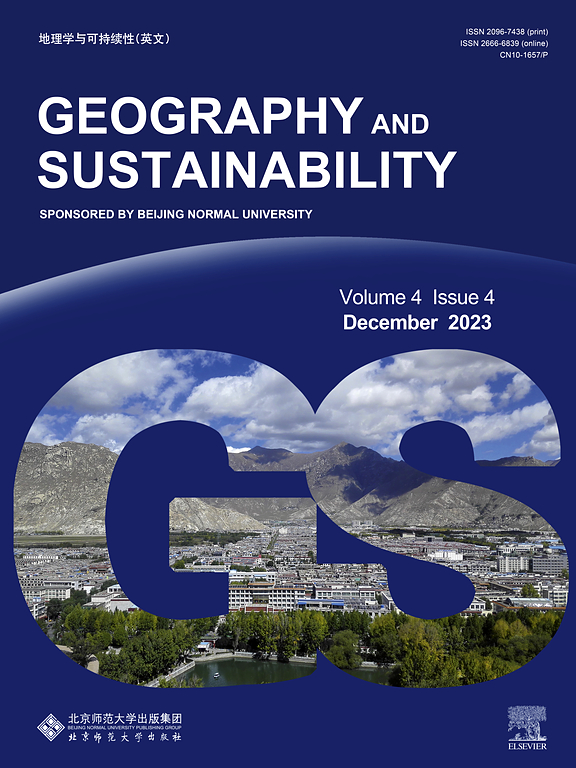Ecosystem-dependent two-stage changes in soil organic carbon stock across the contiguous United States from 1970 to 2014
IF 8
1区 环境科学与生态学
Q1 GEOGRAPHY, PHYSICAL
引用次数: 0
Abstract
Temporal dynamics in soil organic carbon (SOC) play a crucial role in the global carbon cycle. How warming affects SOC change has been widely studied at the site scale, mainly through short-term manipulative experiments. Decades-long SOC dynamics in ecosystems can be complicated, particularly as real-world warming rates varied on decade-scale. However, the lack of long-term repeated observations on whole-profile SOC limits our understanding of SOC dynamics across large regions. Herein, we reconstructed 45 years of SOC dynamics (1970–2014) in topsoil (0–30 cm) and subsoil (30–100 cm) using 10,639 soil profiles from forest and cropland across the contiguous United States, and investigated their relations with key dynamic environments (e.g., climate, vegetation and nitrogen). We further examined the spatial pattern of SOC stock changes at a finer scale (∼2 km) using machine learning techniques. Our results revealed ecosystem-dependent, two-stage changes of SOC stock, characterized by continental-scale halts in SOC loss following warming deceleration since the late 1990s. This shift led to an overall increase in SOC stock of 1.41 % in forest and 1.14 % in cropland within the top 1-meter over 45 years. Temperature was the primary factor related to topsoil SOC losses, whereas soil water content may primarily control subsoil SOC change. Notably, a threshold effect of warming rates on SOC loss was identified in both topsoil and subsoil. These findings provide new insights into long-term whole-profile SOC dynamics at a large scale, offering valuable implications for carbon sequestration to support sustainable development in different ecosystems.

1970年至2014年美国相邻地区土壤有机碳储量的生态系统依赖两阶段变化
土壤有机碳(SOC)的时间动态在全球碳循环中起着至关重要的作用。气候变暖对土壤有机碳变化的影响已经在站点尺度上进行了广泛的研究,主要是通过短期的可操作实验。生态系统中长达数十年的有机碳动态可能是复杂的,特别是当现实世界的变暖速度在十年尺度上发生变化时。然而,缺乏对全剖面有机碳的长期重复观测限制了我们对大区域有机碳动态的理解。在此基础上,利用美国10639个森林和农田土壤剖面,重建了表层土壤(0-30 cm)和底土(30-100 cm) 45年的有机碳动态(1970-2014),并研究了它们与关键动态环境(如气候、植被和氮)的关系。我们使用机器学习技术进一步研究了更精细尺度(~ 2公里)上SOC储量变化的空间格局。结果表明,自20世纪90年代末以来,碳储量的变化依赖于生态系统,具有两阶段的变化特征,其特征是大陆尺度的碳储量损失在变暖减速后停止。在45年的时间里,这一变化导致森林土壤有机碳储量增加1.41%,耕地土壤有机碳储量增加1.14%。温度是影响表层土壤有机碳损失的主要因素,而土壤含水量可能是影响底土有机碳变化的主要因素。值得注意的是,升温速率对表层土壤和底土有机碳损失都存在阈值效应。这些发现为大规模研究长期整体有机碳动态提供了新的见解,为支持不同生态系统的可持续发展提供了有价值的碳固存建议。
本文章由计算机程序翻译,如有差异,请以英文原文为准。
求助全文
约1分钟内获得全文
求助全文
来源期刊

Geography and Sustainability
Social Sciences-Geography, Planning and Development
CiteScore
16.70
自引率
3.10%
发文量
32
审稿时长
41 days
期刊介绍:
Geography and Sustainability serves as a central hub for interdisciplinary research and education aimed at promoting sustainable development from an integrated geography perspective. By bridging natural and human sciences, the journal fosters broader analysis and innovative thinking on global and regional sustainability issues.
Geography and Sustainability welcomes original, high-quality research articles, review articles, short communications, technical comments, perspective articles and editorials on the following themes:
Geographical Processes: Interactions with and between water, soil, atmosphere and the biosphere and their spatio-temporal variations;
Human-Environmental Systems: Interactions between humans and the environment, resilience of socio-ecological systems and vulnerability;
Ecosystem Services and Human Wellbeing: Ecosystem structure, processes, services and their linkages with human wellbeing;
Sustainable Development: Theory, practice and critical challenges in sustainable development.
 求助内容:
求助内容: 应助结果提醒方式:
应助结果提醒方式:


